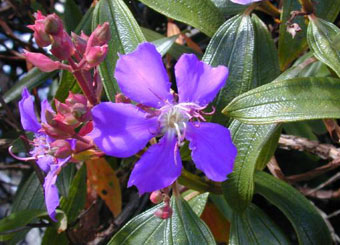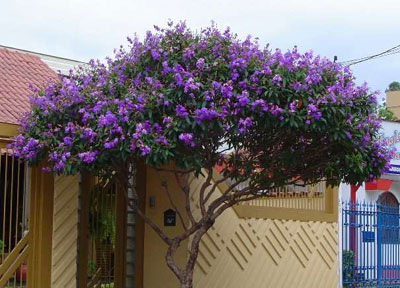Human Flower Project
Friday, March 03, 2006
Quaresmeira—Purple for Lent
Lent is a season of deprivation, but a Brazilian tree can’t be deterred from exuberance.

Blossom of Tibouchina granulosa
Photo: Forest and Kim Starr
With Ash Wednesday, most Christian denominations enter a season of self-imposed discipline. During Lent, parishioners turn inward, surrendering distractions and pleasures in the spirit of Christ’s suffering and death.
In many churches the altar is stripped of flowers for the Lenten season and draped with purple, in a sombre mood. (Many of the cofradias or religious brotherhoods of Latin America favor cassocks of purple, to convey dignity and mourning—also royalty.) We found quite a number of parishes in the U.S. are quite explicit about forbidding flowers—for example, this Catholic church in Lewisburg, Pennsylvania and this Episcopal parish in Arlington, Virginia.
 A Lenten service
A Lenten service
(purple vestments and no flowers)
in Atlanta, Georgia
Photo: St. John’s Lutheran Church
The Church of the Ascension in Pittsburgh, as others, finds some botanical wiggle-room. “Some people have wondered why we have greens on the altars in Lent.” (The Episcopalians are known—both favorably and disparagingly—for their powers of compromise.) “Greens are a half-way place between those who insist the altars should be bare in Lent, and those who believe we should have flowers in Lent. Interestingly, the greens actually cost as much as flowers.”
 Lenten procession
Lenten procession
(everyone in purple)
from the Church of San Bartolo, Antigua, Guatemala, 2000
Photo: Vince Lindgren
We have found, however, a much lovelier accommodation in Brazil: the quaresmeira or Lent-season tree. Tibouchina granulosa, native to both Brazil and Bolivia, is one of the largest of the tibouchina genus, growing 16 to 40 feet tall.
And fittingly, it’s crowned with rich purple blooms each year during Lent. (Thanks to Elizabeth Wynne-Jones of Rio de Janeiro for guiding us to this wonder of the Brazilian spring.)
We’re uncertain whether the blooms are actually cut and arranged on altars during Lent or just secretly enjoyed—an outdoor delight during these weeks of public penitence. May our friends in Brazil once more enlighten us.

Tibouchina granulosa (a.k.a. quaresma and quaresmeira)
Photo: Arvores Brasil
Tibouchina apparently likes the Australian coastal climate. A small variety known as glory bush is a possibility in zones 9-10 of the U.S, though, fittingly, some tenacity may be required: “It has been our experience Tibouchina can be difficult to establish. After planting, they may seem to lack the will to grow for a season or two, but then suddenly take off. After that, Tibouchina is easy.”
Can penitence be beautiful? Several centuries of icon painters were sure of it. And the purple quaresmeira makes us certain of it, too.
Culture & Society • Gardening & Landscape • Religious Rituals • Permalink




